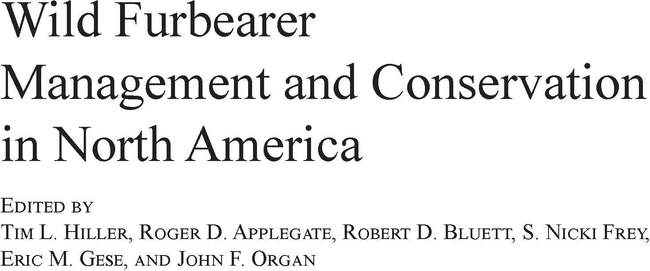For information about this book, including the Table of Contents, click here.
Published 9 February 2024
© 2024 Wildlife Ecology Institute
https://doi.org/10.59438/QXDE4827
© 2024 Wildlife Ecology Institute
https://doi.org/10.59438/QXDE4827
INTRODUCTION
There is a continuing need to assess the status (distribution and population abundance) of furbearing species throughout North America for state, provincial, tribal, and federal agencies for effective management and conservation of furbearers. With an expanding population of humans and continued changes in land-use practices, loss and fragmentation of habitat, declines in prey populations, increases in disease transmission from domestic species, and increasing competition with other species, many fish and wildlife agencies have prioritized the management and conservation of some furbearing species. Paramount to making informed decisions regarding management of furbearer populations is accurate information about their current distribution and population status. Assessing the status of furbearer populations can be a daunting endeavor because many furbearing species are mobile, elusive, cryptic, and behaviorally responsive to many human-associated activities. Challenges increase for those furbearing species with relatively low population densities. Lastly, limited financial and staffing resources, restricted access to private lands, political and social considerations, and government regulations may further constrain the level of feasibility or acceptability of these efforts.
Prior to a biologist or manager implementing a monitoring plan, a diligent and thorough planning effort can improve efficacy by determining the: 1) population parameter(s) necessary to address the management or research need, 2) level of precision and accuracy needed for these parameter estimates, 3) level of assurance needed to acquire a reasonable and acceptable answer, and 4) appropriate time interval to repeat monitoring to produce updated information. Thus, requirements for planning include: 1) precise identification of the questions to be answered, 2) knowledge of biology and behaviors of the furbearing species of interest, 3) recognition of the physical and social environment in which the data are to be collected, 4) an understanding of threats or stressors to the furbearing species of interest, 5) development of suitable analytical processes that will provide some assurance surrounding the estimate(s) provided, and 6) selection of the appropriate survey method(s) to conduct in the field. All of these requirements may not apply to every monitoring situation, and some can be handled in a perfunctory manner. Other requirements, however, may be associated with considerable effort to arrive at some suitable compromise to ensure an appropriate estimate or answer will result from a survey. A pilot season or collection of preliminary data can provide much needed clarity toward developing a suitable monitoring program.
There is a continuing need to assess the status (distribution and population abundance) of furbearing species throughout North America for state, provincial, tribal, and federal agencies for effective management and conservation of furbearers. With an expanding population of humans and continued changes in land-use practices, loss and fragmentation of habitat, declines in prey populations, increases in disease transmission from domestic species, and increasing competition with other species, many fish and wildlife agencies have prioritized the management and conservation of some furbearing species. Paramount to making informed decisions regarding management of furbearer populations is accurate information about their current distribution and population status. Assessing the status of furbearer populations can be a daunting endeavor because many furbearing species are mobile, elusive, cryptic, and behaviorally responsive to many human-associated activities. Challenges increase for those furbearing species with relatively low population densities. Lastly, limited financial and staffing resources, restricted access to private lands, political and social considerations, and government regulations may further constrain the level of feasibility or acceptability of these efforts.
Prior to a biologist or manager implementing a monitoring plan, a diligent and thorough planning effort can improve efficacy by determining the: 1) population parameter(s) necessary to address the management or research need, 2) level of precision and accuracy needed for these parameter estimates, 3) level of assurance needed to acquire a reasonable and acceptable answer, and 4) appropriate time interval to repeat monitoring to produce updated information. Thus, requirements for planning include: 1) precise identification of the questions to be answered, 2) knowledge of biology and behaviors of the furbearing species of interest, 3) recognition of the physical and social environment in which the data are to be collected, 4) an understanding of threats or stressors to the furbearing species of interest, 5) development of suitable analytical processes that will provide some assurance surrounding the estimate(s) provided, and 6) selection of the appropriate survey method(s) to conduct in the field. All of these requirements may not apply to every monitoring situation, and some can be handled in a perfunctory manner. Other requirements, however, may be associated with considerable effort to arrive at some suitable compromise to ensure an appropriate estimate or answer will result from a survey. A pilot season or collection of preliminary data can provide much needed clarity toward developing a suitable monitoring program.
Citation:
Gese, E. M., P. A. Terletzky, H. S. Cooley, F. F. Knowlton, and R. C. Lonsinger. 2024. Survey and monitoring methods for furbearers. Pages 15.1–15.44 in T. L. Hiller, R. D. Applegate, R. D. Bluett, S. N. Frey, E. M. Gese, and J. F. Organ, editors. Wild furbearer management and conservation in North America. Wildlife Ecology Institute, Helena, Montana, USA. https://doi.org/10.59438/QXDE4827
Citation:
Gese, E. M., P. A. Terletzky, H. S. Cooley, F. F. Knowlton, and R. C. Lonsinger. 2024. Survey and monitoring methods for furbearers. Pages 15.1–15.44 in T. L. Hiller, R. D. Applegate, R. D. Bluett, S. N. Frey, E. M. Gese, and J. F. Organ, editors. Wild furbearer management and conservation in North America. Wildlife Ecology Institute, Helena, Montana, USA. https://doi.org/10.59438/QXDE4827
Copyright 2024 Wildlife Ecology Institute



